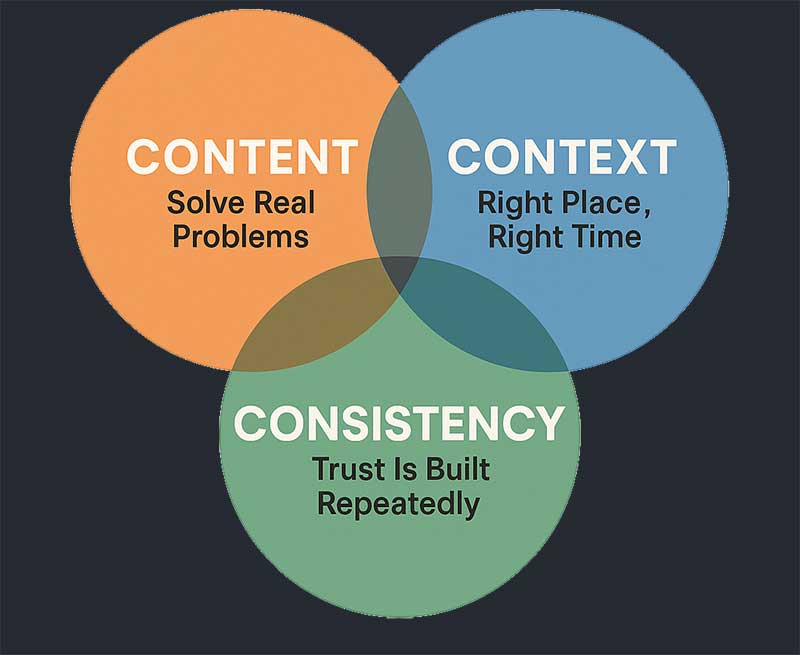
The Content Marketing Blueprint: 10 Proven Hooks That Drive Real Results
If you want your content to stand out, resonate, and convert, it takes more than consistency and keywords. It takes a strategy rooted in psychology, human connection, and proven content marketing best practices.
That is what the Content Marketing Blueprint is all about.
Over the years, I have worked with companies across industries to develop content that aligns with their audience’s mindset and solves real business problems.
The result is a refined framework built around 10 hook points that consistently improve engagement, connection, and performance.
This page brings those hooks together in one place. Each one has been broken down in detail in a dedicated blog post with actionable insights and examples.
If you are building your content strategy or refining what you already have, this blueprint will give you a strong foundation.
Why Hook Points Matter in Content Marketing
Hook points are not gimmicks. They are strategic entry points that align with how people consume and respond to content. Whether you are writing blog posts, landing pages, email sequences, or social content, leading with a strong hook is one of the most important content marketing best practices you can apply.
Think of this as your working blueprint for creating content that:
- Grabs attention in the first few seconds
- Builds trust and emotional connection
- Aligns with your ideal customer persona
- Drives deeper engagement and conversions
Let us dive into the 10 hook points you can use immediately.
The 10-Point Content Marketing Hook Series
1. The Power of Future Pacing in Your Content
Capture attention by showing what’s just around the corner. Future pacing uses curiosity and value sequencing to keep people scrolling, watching, and engaging.
2. Turning Unresolved Problems Into Content Gold
Start with the tension. People are motivated to solve what’s still broken. This principle shows you how to lead with unresolved problems to drive engagement.
3. Why Situational Relatability Builds Trust Instantly
Trust comes from “you get me” moments. Relatable stories create fast emotional alignment—and that leads to loyalty.
4. Context Framing: Start with the End in Mind
Show your audience the outcome up front. When they know what’s in it for them, they’ll follow you through the entire message.
5. Storytelling That Converts: Start with the Drama
Skip the backstory. Start where the tension begins. This storytelling method builds momentum and keeps readers or viewers hooked from the first line.
6. Why a Little Controversy Can Skyrocket Engagement
Safe content gets scrolled past. Bold content gets remembered. Learn how to challenge norms without burning bridges—and spark real conversation.
7. How Novelty Rewires the Brain to Pay Attention
We’re wired to notice what’s new. Here’s how to inject novelty into your content without reinventing your strategy.
8. The Insight Hook: Teaching with Aha Moments
Insight beats advice. This post walks through how to shift from tips to transformative ideas that change how people think—and what they do next.
9. How to Engage the 5 Senses in Digital Content
Great content feels real. By tapping into sensory language and design, you create a richer, more memorable user experience.
10. Find Your Common Enemy to Rally the Right Audience
Want a loyal audience? Give them something to unite around. Naming a common enemy creates clarity, alignment, and brand momentum.
Build Your Own Content Marketing Blueprint
Each of these 10 principles can stand alone. But together, they form a content marketing blueprint that helps you create connection, deliver value, and drive results.
Whether you’re refining your messaging, redesigning your site, or planning your next campaign, these hooks are practical tools that work in real business environments.
Looking to apply these principles to your own content strategy?
“Jon Searle Taught Me:
Long-tail keywords are better than short-tail ones in search. While short tails might get more clicks, those clicks don’t often lead to conversions.
Setting up goals for paid search and SEO is paramount to client success and renewals. Clients want to speak directly with the SEO expert, not just read nice-looking monthly reports. When clients reach their goals and there’s a feedback loop, that’s where the magic happens—with conversions and new sales.
Retargeting on YouTube and Google can be more effective than anything else in your marketing arsenal.
Monthly SEO work without content services isn’t a good idea. And using content in paid media can be a huge win!
Blog posts need to be longer—and meaningful.
Be honest. Use data. Have integrity and create trust. This will allow you to zag when everyone else is zigging.
A good growth marketer and consultant typically uses the same vocabulary over the years, and this is how it goes:
– Do you have a plan to find new customers?
– What are you doing to keep and grow existing customers?
– What do you do when customers start to leave? Do you have a plan?
This has become my vocabulary—and it’s Jon’s too. I’ve been part of it for more than two years.
New channels and tactics come and go, like Facebook and YouTube, SEO and SEM, paid PPC, and content, but they all still solve the same needs: finding new customers, growing current ones, and winning back those that start to leave.
Digital marketing is too important to leave to chance. Hire Jon Searle—he’ll exceed any expectations you’ve had with other resources.”

Cathy Veri
Principal, careerguide.ai
Jon is a master at digital media strategy. He brings vast depths of technical knowledge, audience insight, performance strategy, and creative problem solving to every conversation. I had the pleasure of working with Jon for nearly two years on some really huge, hairy, never-gonna-happen projects. Jon makes clients and everyone around him look good, he exceeds revenue goals, and I don’t know how he does this – but the bigger the challenge, the more fun we had!”
Digital Marketing Insights Blog
-

What Are the 3 C’s of Content Marketing?
If you’re trying to build a content marketing strategy that actually works, not just one that sounds good in meetings,…
-

Effective Link Building Strategies for Rapid SEO Growth
Link building has always been a foundational element of SEO success. But as algorithms have evolved, so has the strategy…
-

SEO Competitor Analysis Techniques for Winning Strategies
Understanding your competition is one of the most overlooked opportunities in digital marketing. Too often, businesses focus solely on their…





